-
Posts
14,343 -
Joined
-
Last visited
-
Days Won
25
Content Type
Profiles
Forums
Blogs
Gallery
Events
Store
Posts posted by Ed_Haynes
-
-
Naik Tika Khan, M.M., Hong Kong-Singapore Battalion, Royal Garrison Artillery
Named: H.K.S.B. 1390 NAIK TIKA KHAN. H.K-S.BN:R.G.A.
An immensely uncommon George V Military Medal to an Indian serving with the Hong Kong-Singapore Battalion, Royal Garrison Artillery. London Gazette 25 April 1918.
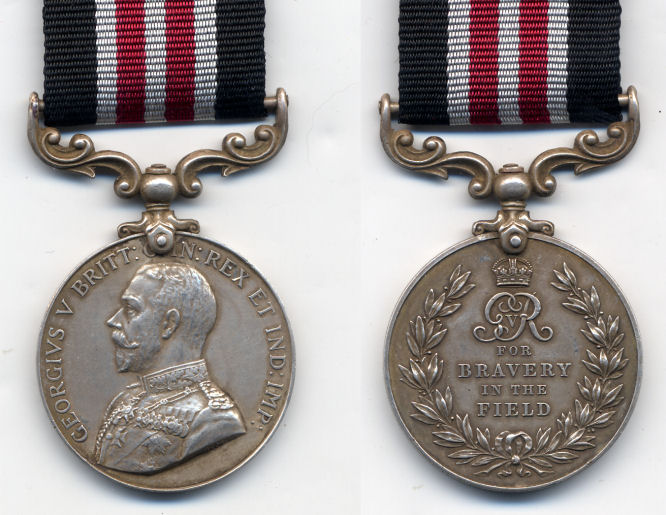
 0
0 -
As some of these are on "home leave" just now, may I add a few?
1979 Naik Murad Khan, IDSM, 18th King George's Own Tiwana Lancers
OK, OK, most IDSMs look pretty much the same if you ignore the edge. I'll only put up a few "interesting" ones.
This one for Persia 1910 - 15 April 1910, IAO 933/1910.
Possibly one of the first four medals to carry GV's image. See OMRS Journal 25 (1996). Though probably a WWI-era reissue for an earlier Edward VII medal? The "Royal Mint" variety.
Gazette of India 19 November 1910.
On 15 April 1910, a detachment of the 18th Tiwana Lancers was detailed to accompany the Isfahan Consular Escort, with Mr. J. H. H. Bill of the Government of India Foreign Department, on deputation as British Consul at Shiraz. Attacked by robbers between Kumisheh and Abadah, two Sowars of the 18th?s escort were killed, while the bravery of Naik Marad Khan and two fellow cavalrymen was recognised by the award of the I.D.S.M.
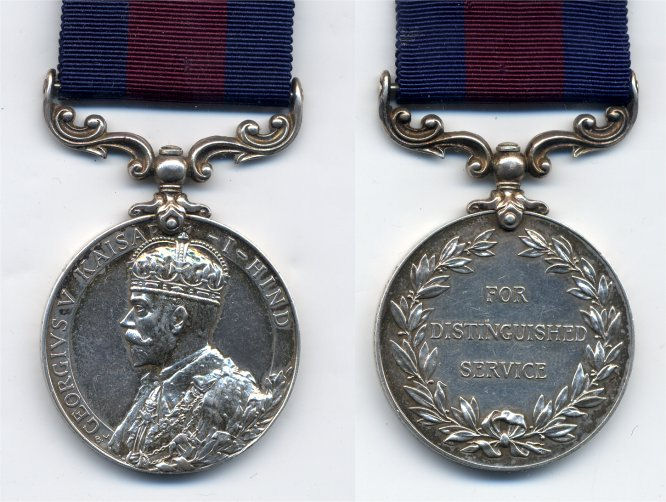
 0
0 -
Thanks for jogging this thread back to life, Christophe. I was worried that it was dead.
 0
0 -
Not quite knowing what earthly meaning the word "native" has (except as a synonym for another "n-word"), I shall ignore Purves' quote.
These were awards, in the spirit of the bronze medals that had been awarded to non-combatants and "followers" (= support personnel) of the Indian Army since the "Burma 1885-7" clasp to the IGS 1854.
One reason they are more uncommon is that they were MUCH less valued and tended to be discarded. Likewise, given the low social status of the recipients, no great efforts were made to track them down and award these medals, helping to explain the lots of unissued medals that occasionally surface on the market. The real reason for their scarcity, however, is that while approximately 6,500,000 silver war medals were awarded, only some 110,000 bronze medals were given out.
I have several (all to Indians, of course), and find them to be immensely interesting! While research on the individuals is completely impossible, research on the units is very promising. A recent acquisition (still naked, sorry), to "2066 LABR TULSI, 75 IND LAB COY".
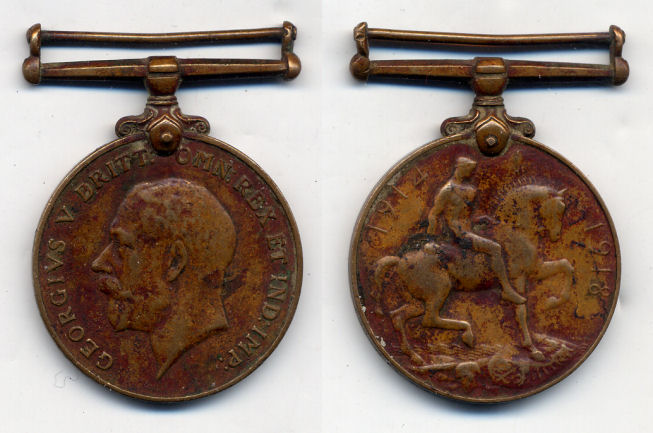
 0
0 -
I've had this one for a long time.
Anyway, one more NIB to add to the list.
I believe it's written in Russian, or at least in Cyrilic.
As far as I can tell, on the suspension I think it says: ARMIIN AWARGA . On the Medal itself, above the VI I suppose it says: SLARTAKIAD. Btw, I have not the slightest idea what this would mean!

Would this make any sense?! Could someone help and translate this?
Thanks,
Dolf
Would guess this is for someone's "VI Spartikad", 6th sports meet. There are a lot of these "Spartikad" badges in Battushig and maybe ten times that number "still in the wild". I can make no sense at present out of the suspension legend. Something to do with the military??
I still need to find a good Mongolian dictionary!
0 -
Historically
 but aesthetically
but aesthetically  .0
.0 -
We do need to be careful to distinguish between between awards for Gulf War II ("Liberation" of Kuwait) and Gulf War III (Invasion and Occupation of Iraq). Some of these are GWII, some GWIII, some broader than either. Yes, very complex, sprawling, and uncoordinated.
(And then there's Afghanistan, and . . . ?)
0 -
I have been looking for this image for several month now. Got Schwarzburg? Yes indeed:
[attachmentid=32752]Oh . . . (uncharcteristically) speechless . . .
 0
0 -
PAK/200043 AC2 MOHD SAFDAR. R.P.A.F.
1- General Service Medal: Kashmir 1948
2- Independence Medal
3- 1939-45 Star
4- WWII War Medal
5- Indian Service Medal
Only the Independence Medal is named, as shown above. He must have left by 1956, or there would have been a Republic Medal. Original ragged mounting.
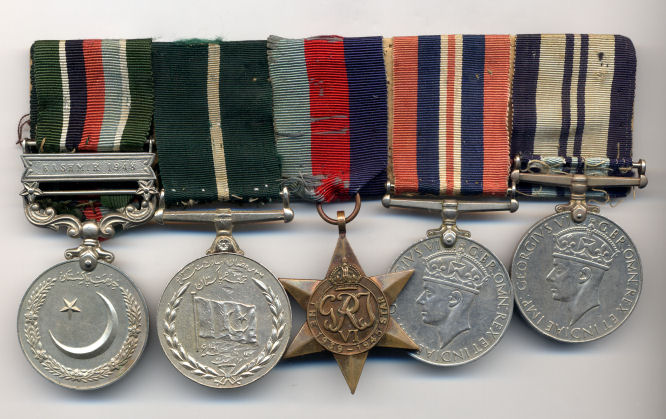
 0
0 -
799 FLT. CDT. SHAKIR HUSSAIN AIR H. QRS.
1- War Medal 1965
2- Independence Medal
3- Republic Medal
4- WWII War Medal
5- Indian Service Medal
Only the Indepndence Medal named, as shown above. Original ragged mount.
He almost surely made it well beyond Flight Cadet" in the years from 1947 to 1965 (at least). A research challenge.
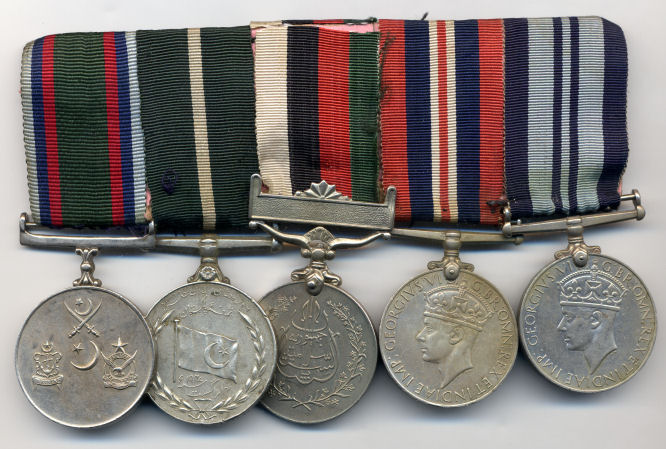
 0
0 -
O. NO. 630129 COOK U. BAKSH
1- General Service Medal: Kacch 1965
2- War Star 1965
3- War Star 1971
4- Campaign Medal 1965
5- Campaign Medal 1971
6- Quaid-i-Azam Centennial
7- 1400 Hijra Medal
8- Oman, Peace Medal
Only the Istar-i-Herb 1385 / War Star 1385 [A.H. = 1965 C.E.] is named, as shown above. Very ragged mount, a tattered tailor's lable on reverse, so probably halal.
Interesting for the Oman medal.
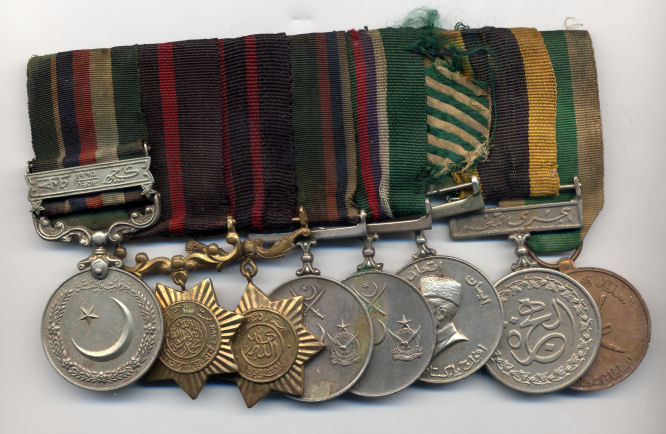
 0
0 -
Ed,
There's never enough!!
 I have a few of those in my display. I hope to add more. Do you think that my apartment manager would mind me adding a doorway into the vacant apartment next to mine? I need more wall space. I have too many medals in notebooks!!!
I have a few of those in my display. I hope to add more. Do you think that my apartment manager would mind me adding a doorway into the vacant apartment next to mine? I need more wall space. I have too many medals in notebooks!!!Doc
Wish I could have mine home all the time. The live off-site, except when visiting on "home leave".

A few Pakistani groups, maybe?
As with most medals from elsewhere that India in South Asia (Bangladesh, Nepal, Sri Lanka, etc.), most Pakistani medals are unnamed. Not only does this reduce their interest and research value, but it has also led to a mammoth problem industry in the faking of groups. This is made easier by virtue of the fact that WWII medals are not officially named for soldiers who went to Pakistan.
I would estimate -- conservatively -- that 80% of the Pakistani "groups" appearing on the market are fraudulent. I'll post a few that I am reasonably comfortable with.
383012 Recruit Abdul Ghafur, 16th Punjab Regiment
1- The General Service Medal, 1947 - KASHMIR 1948
2- The Pakistan Independence Medal, 1947 - 383012 RECT ABDUL GHAFUR 16. PB R (as is unfortunately usual, the Independence Medal is the sole named medal in the group)
3- The Pakistan Republic Commemorative Medal
4- United Arab Emirates, 1976 Armed Forces Amalgamation Medal
5- Abu Dhabi, Defence Forces Service Medal
An interesting group, in that it demonstrates service -- as something more than a recruit, to be sure -- on loan to the Abu Dhabi and the United Arab Emirates, ca. 1976. A nice, unusual, if somewhat tattered group. Were it not so tattered, however, I might doubt its authenticity!
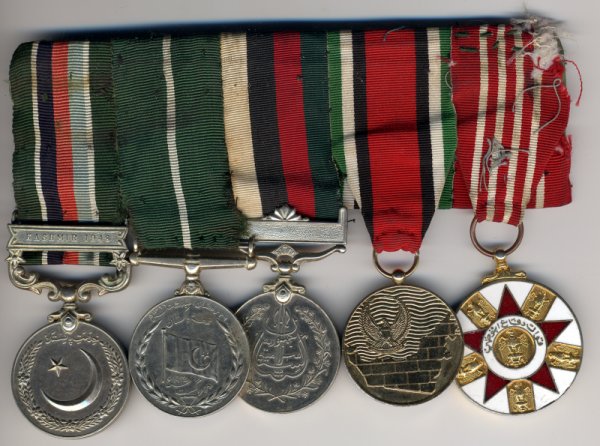
 0
0 -
Enough????
 0
0 -
Ten-Year Service Medal
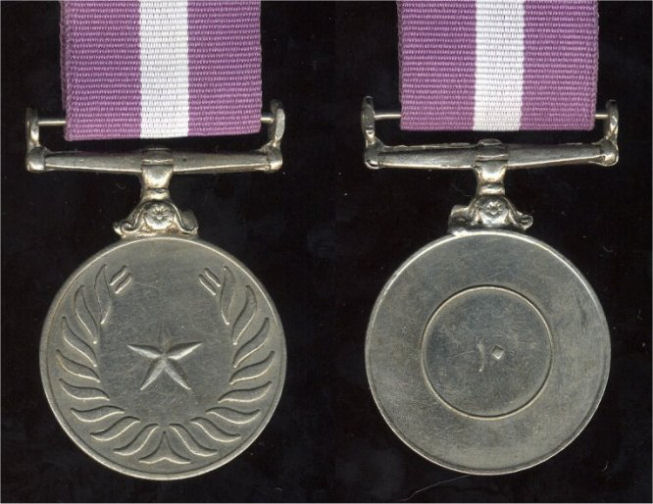
 0
0 -
Twenty-Year Service Medal
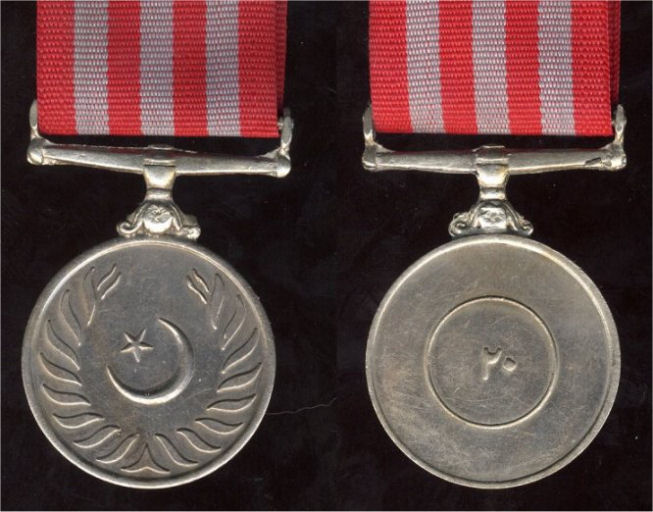
 0
0 -
Hijri Medal 1401
Issued to commemorate the completion of the fourteenth century of the Hijri era (1401 A.H.) on 22 November 1979.
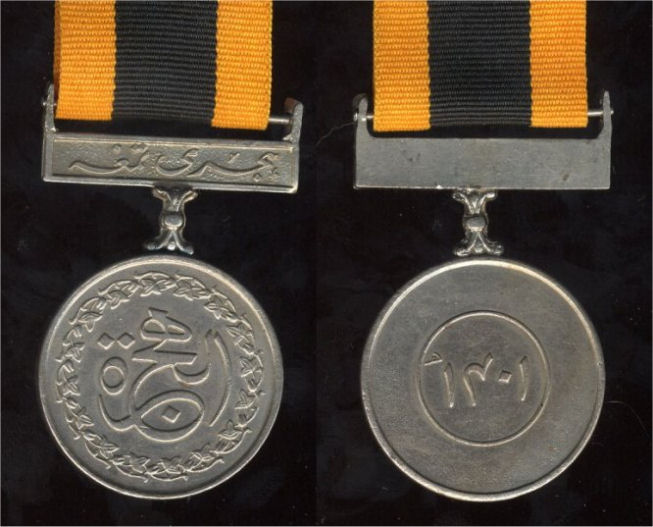
 0
0 -
Tamgah-i-Sad Saala Jashan-i-Wiladat Quaid-i-Azam / Centenial Medal of Quaid-i-Azam Muhammad Ali Jinnah
Awarded to commemorate the birth centenary of Quaid-i-Azam Muhammad Ali Jinnah, the founder and first Prime Minister of Pakistan, on 25 December 1976.
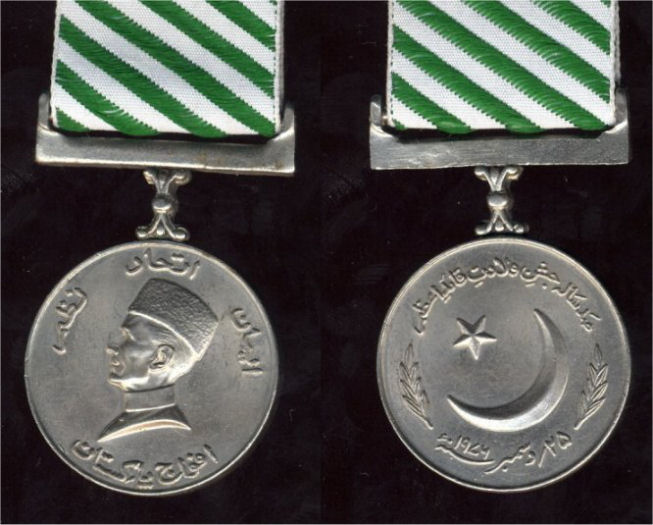
 0
0 -
1971 Tamgha-i-Jang / 1971 War Medal
Awarded for general service in the 1971 Pak-Indian War.
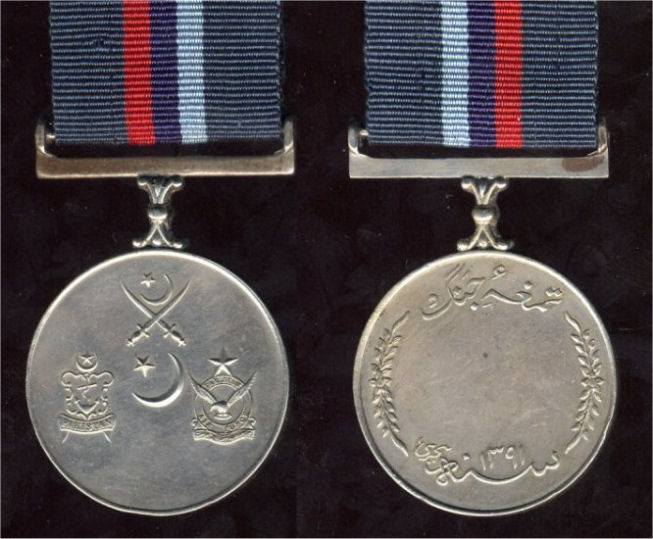
 0
0 -
Istar-i-Herb 1391 / War Star 1391 (A.H. = 1971 C.E.)
Awarded for combat service in the 1971 Pak-Indian War.
Obverse: A bronze seven-pointed star, point up. In the center, ?Allah-u-Akbak? or ?God is Great?. Around this, ?Star-i-Herb / 1391 Hijri? or ?War Star / 1391 A.H. [= 1971 C.E.]?. Suspended by an ornate straight bar.
Reverse: Plain, a central circle, within which the medal is sometimes named (although it is often encountered unnamed).
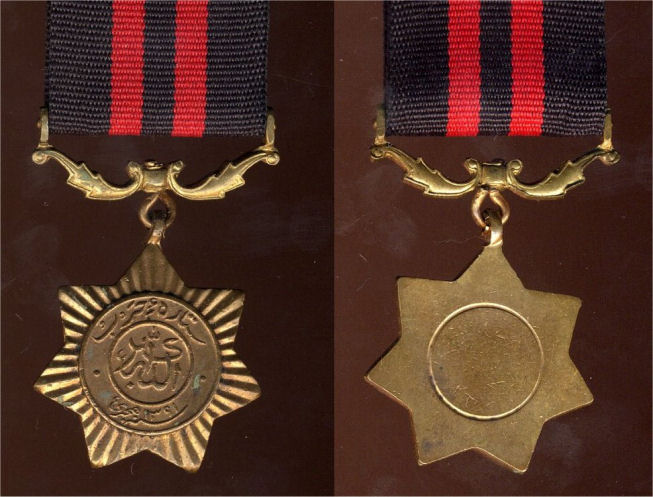
 0
0 -
1385 Tamgha-i-Jang / 1385 [A.H. = 1965 C.E.] War Medal
Awarded for general service in the 1965 Pak-Indian War.
Obverse: 37 mm, circular, copper-nickel. In the center, the star and crescent, above the insignia of the Pakistani army, to the left that of the Pakistani navy, and to the right the crest of the air force. The medal is suspended from a plain non-swiveling straight-bar suspender. The medal is usually unnamed.
Reverse: In the center, the date ?1385? (A.H. = 1965 C.E.) in Urdu and Bengali. Above, the curved Urdu inscription ?Tamgha-i-Jang?, or ?War Medal? and, below, the same in Bengali, separated by wreaths of each side.
Ribbon: 31 mm, green, with edge stripes (reading inwards) of light blue, dark blue, red. Light blue 3 mm, dark blue 3 mm, red 3 mm, green 13 mm, red 3 mm, dark blue 3 mm, light blue 3 mm.

 0
0 -
Istar-i-Herb 1385 / War Star 1385 [A.H. = 1965 C.E.]
Awarded for Combat Service in the 1965 Pak-Indian War.
This war began as a series of border flare-ups along undemarcated territory at the Rann of Kutch in the southeast in April and soon after along the cease-fire line in Kashmir. The Rann of Kutch conflict was resolved by mutual consent and British sponsorship and arbitration, but the Kashmir conflict proved more dangerous and widespread. In the early spring of 1965, UN observers and India reported increased activity by infiltrators from Pakistan into Indian-held Kashmir. Pakistan hoped to support an uprising by Kashmiris against India. No such uprising took place, and by August India had retaken Pakistani-held positions in the north while Pakistan attacked in the Chamb sector in southwestern Kashmir in September. Each country had limited objectives, and neither was economically capable of sustaining a long war because military supplies were cut to both countries by the United States and Britain. On 23 September, a cease-fire was arranged through the UN Security Council.
Obverse: A bronze seven-pointed rayed star, point down, 35-mm. In the center, the Shahadat (?There is no God but God and Muhammad is His Messenger?), surrounded by the name of the medal on a circular band, ?Istar-i-Herb? in Urdu and Bengali, or ?War Star 1385. The medal is suspended from an ornate straight-bar non-swiveling suspender.
Reverse: Plain, a central circle, within which the medal is sometimes named (although it is often encountered unnamed).
Ribbon: 33 mm, black, with a central 5 mm red stripe. Black 14 mm, red 5 mm, black 14 mm.
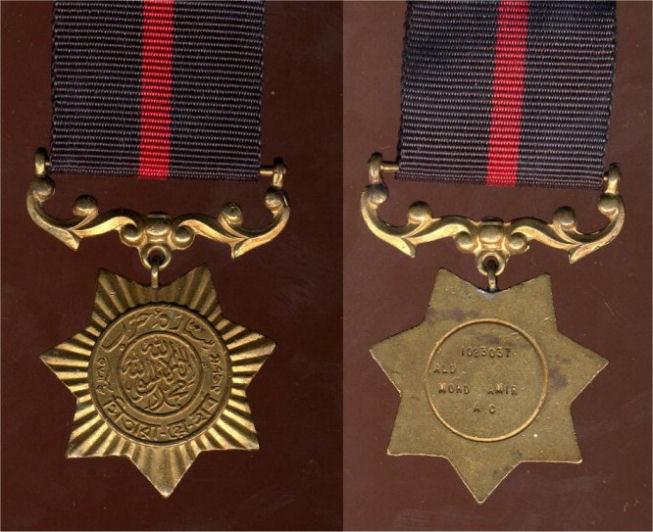
 0
0 -
Pakistan Independence Day Golden Jubilee Medal
Issued to comemorate the fiftieth anniversary of Pakistani independence, 14 August 1947. Awarded to those serving on 14 August 1997.

 0
0 -
Tamgah-i-Pakistan / The Pakistan Medal
Awarded to commemorate Pakistan?s independence in 1947. The medal was awarded to:
?a. Members of the armed forces of Pakistan in commemoration of the change which resulted in the establishment of Pakistan on the 14th August, 1947.
?b. British Officers, warrant officers and other ranks who, on 1st January 1948, were serving in the Armed Forces of Pakistan or India and who volunteered for, were accepted for and subsequently served with the Armed Forces of Pakistan in the Navy, Army or Air Force. Individuals who were eligible for the Indian Independence Medal did not receive this award?
Established: By British Army Council Instruction 741 of 1957. Pakistani statutory basis?
Obverse: 37 mm, circular copper-nickel. The Pakistani flag in the center, surrounded by a wreath. Above, the Urdu inscription ?26 Ramadhan Lambarak 1366 H. / Tamgah-i-Pakistan / 14 August 1947? or ?26 Ramadhan Lambarak 1366 H. / Pakistan Medal / 14 August 1947?. Below, the date ?15 August 1947?. Suspended from a straight non-swiveling bar suspender. Frequently named on the edge.
Reverse: In the center, the monogram of King George VI (the new one), ?GVIR? and the inscription ?GEORGIVS VI D.G. BR. OMN. REX.?
Ribbon: 31 mm, green with a 3 mm white center strips. Green 14 mm, white 3 mm, green 14 mm.
Unlike all other post-Indepepdence Pakistani medals, this one (only) was routinely named on the edge.
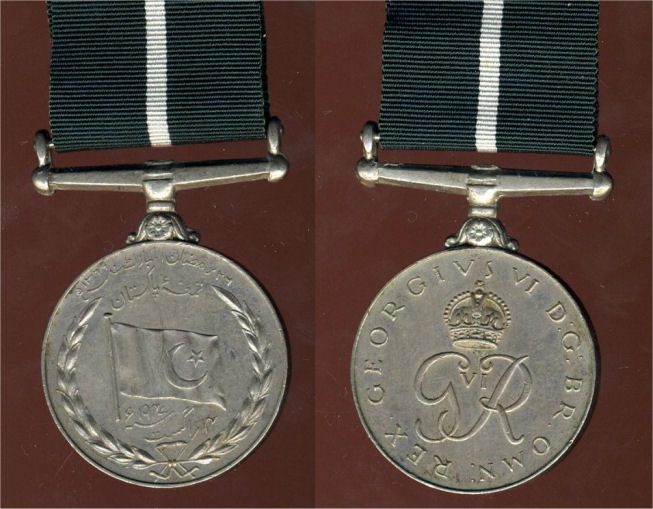
 0
0 -
Pakistan Police Medal for Gallantry
Established 11 August 1954. This one named "MR. MOHD MAHMOOD JAN, EAST PAKISTAN RIFLE."
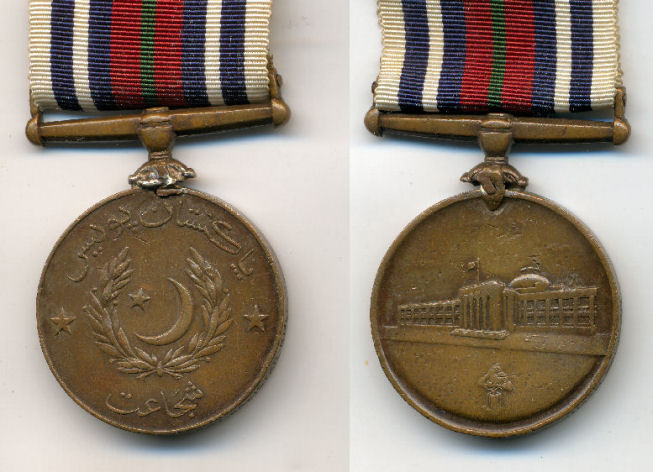
 0
0




Pre-1947 Indian Single Medals
in Great Britain: Orders, Gallantry, Campaign Medals
Posted
3693 Havildar Bir Singh, IDSM, 14th K.G.O. Ferozepore Sikhs
Interesting not only for what it is, but for how I got it. In a silver market in Jaipur (Rajasthan) in 1974, a merchant had two medals. This one and a pedestrian IGS 95 "Punjab Frontier". The IGS was Rs. 100 because it was "old" (around $US5 at that time), while this one was Rs. 75. I got both.
Indian Distinguished Service Medal, George V, 1st variety
Named: "3693 Naik Bir Singh 14th K.G.O. Ferozepore Sikhs"
Son of Sobha Singh, of Mangewal, Maloh, Nabha, Punjab. Jat Sikh.
Awarded IDSM for Gallipoli (H&A shows regt. # as 3694 and rank as Havildar) - 2nd IDSM to unit (47 to regt. for WWI: 36 Gallipoli, 1 Egypt, 10 Mesopotamia) , 2nd to the regt. for Gallipoli (also 1 IOM for this service) - H&A, p. 79: "14th King George's Own Ferozepore Sikhs. . . .3694 Havildar Bir Singh, Gallipoli".
London Gazette Supplement 29 October 1915, p. 10735, "for gallantry and devotion to duty whilst serving with the Indian Expeditionary Force at the Dardanelles" -- No. 3693 Naik Bir Singh, 14th King George's Own Ferozepore Sikhs.
1914, 14th KGO Sikhs went to defend Suez Canal (1 IDSM). Then to Gallipoli for six months. 1 May 1915, 1st Indian Brigade disembarked (14th Sikhs, 69 Punjabis, 89th Punjabis, and 1/6 Gurkhas). The Punjabis were soon withdrawn, as the regiments had Muslim companies, and their loyalty was suspect, while the remainder attached to the 29th Division. 6 May 1915, attached SE of Krithia, Took 3/4 losses at Achi-Baba the night of 4/5 June 1915, but advanced against great odds and uncut wire (80% of B Officers killed, 79% of Indian Officers, and 74% of EM). 31 IDSMs awarded for this action (12 from Ludhiana, 6 Patiala, 5 Ferozepore, 2 Ambala, 2 Nabha [he was one of them?], 2 Maler Kotla, 1 Rawalpindi, and 1 Faridkot) and 1 IOM2 (?). On 7th and 8th attempted to take Kota Chaman Tepe (no success). 10 June, attacked by Turks (4 IDSMs to Patiala Sikhs). 3rd week of August, sent to reinforce Sulva Bay - minor action thereafter. Late March 1916, withdrawn from Gallipoli to Suez Canal; garrisoned Tor and Abu Zeneima on Sinaitic Coast. To Mesopotamia for the remainder of the war (where 2 MC, 1 OBI2, 2 IOM2, 10 IDSM, 4 IMSM).
Battalion suffered 264 killed and 840 wounded in Gallipoli campaign.
He was also MiD 1235/1915 -- London Gazette Supplement, 5 November 1915, p. 11004.
KIA: 3694 Havildar Bir Singh, 14th King George's Own Ferozepore Sikhs, on Friday, 26th October 1917. Commemorated on BASRA MEMORIAL, Iraq.